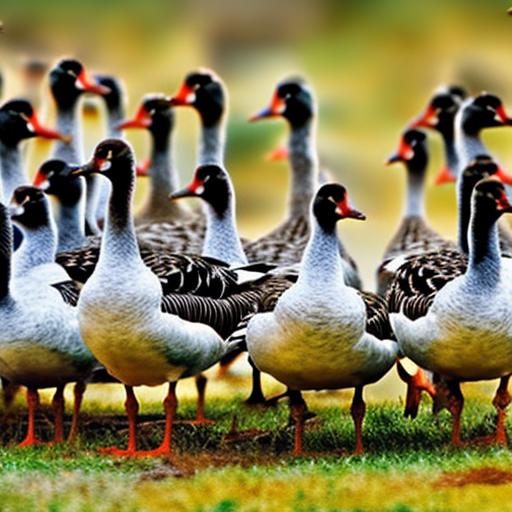The presence of geese in residential neighborhoods has become a growing concern for many homeowners. While these majestic birds can be a beautiful sight in natural habitats, their increasing presence in urban and suburban areas has raised a number of issues. From health and safety concerns to property damage and noise pollution, the impact of more geese on the neighborhood is a complex issue that requires careful consideration and effective solutions.
Key Takeaways
- Introduction to the Issue: The presence of more geese in the neighborhood has raised concerns about health, safety, and property damage.
- The Impact of More Geese on the Neighborhood: Increased geese population has led to noise, mess, and potential aggression, impacting the quality of life for residents.
- Addressing the Health and Safety Concerns: Health risks from goose droppings and potential physical harm from aggressive behavior need to be addressed promptly.
- Legal and Ethical Considerations: Understanding local laws and ethical considerations regarding wildlife management is crucial in finding a solution.
- Effective Communication with the Neighbor: Open and respectful communication with the neighbor about the issue is essential for finding a resolution.
- Exploring Potential Solutions: Exploring options such as habitat modification, deterrents, and professional wildlife management can help mitigate the issue.
- Seeking Assistance from Local Authorities: Involving local authorities and wildlife experts can provide guidance and support in addressing the geese population in the neighborhood.
The Impact of More Geese on the Neighborhood
The increasing population of geese in residential neighborhoods can have a significant impact on the local environment and community. One of the most noticeable effects is the accumulation of droppings, which can not only be unsightly but also pose health risks to humans and pets. The high nitrogen content in goose droppings can lead to algae blooms in water bodies, affecting the local ecosystem. Additionally, the aggressive behavior of geese during mating season can pose a threat to residents, especially children and the elderly. Their territorial nature can lead to confrontations and even physical harm. Furthermore, the noise generated by large flocks of geese can disrupt the peace and quiet of the neighborhood, causing annoyance and stress for residents.
On a more personal level, the presence of geese can also lead to property damage. Their feeding habits can destroy lawns and gardens, while their nesting activities can clog gutters and drains. This can result in costly repairs and maintenance for homeowners. Overall, the increasing population of geese in residential neighborhoods can have a detrimental impact on the quality of life for residents and the overall aesthetics of the community.
Addressing the Health and Safety Concerns
Addressing the health and safety concerns associated with the increasing population of geese in residential neighborhoods is crucial for maintaining a safe and harmonious community. One approach to mitigating these concerns is through proactive measures to discourage geese from settling in the area. This can include implementing landscaping techniques that make the environment less attractive to geese, such as planting tall grasses or using natural deterrents like predator decoys. Additionally, creating physical barriers around water bodies and other areas where geese congregate can help limit their access to these spaces.
Another important aspect of addressing health and safety concerns is educating residents about the potential risks associated with interacting with geese. This can involve providing information about the proper way to coexist with wildlife, as well as raising awareness about the potential health hazards posed by goose droppings. Encouraging responsible pet ownership, including keeping dogs on leashes around geese, can also help minimize confrontations and reduce the risk of injury.
Legal and Ethical Considerations
When addressing the issue of more geese in the neighborhood, it is important to consider both legal and ethical considerations. From a legal standpoint, it is essential to understand the regulations and restrictions regarding wildlife management in residential areas. In many cases, geese are protected under federal and state laws, which may limit the options available for controlling their population. It is important to consult with local wildlife authorities and legal experts to ensure that any actions taken comply with applicable laws and regulations.
From an ethical perspective, it is important to approach the issue with compassion and respect for wildlife. While addressing the impact of geese on the neighborhood is necessary, it is important to do so in a humane manner that considers the well-being of the animals. This may involve exploring non-lethal methods of population control, such as habitat modification or egg addling, which can help manage the goose population without causing harm to the birds.
Effective Communication with the Neighbor
Effective communication with neighbors is essential when addressing the issue of more geese in the neighborhood. Open and respectful dialogue can help foster understanding and collaboration in finding solutions that benefit the entire community. It is important to approach conversations with empathy and a willingness to listen to different perspectives. This can help build trust and create a sense of unity in addressing the issue.
When communicating with neighbors about the impact of geese on the neighborhood, it is important to provide factual information about the potential risks and challenges posed by the increasing goose population. This can help raise awareness and garner support for implementing measures to address these concerns. Additionally, involving neighbors in the decision-making process and seeking their input on potential solutions can help build consensus and promote a sense of ownership over the outcome.
Exploring Potential Solutions

Exploring potential solutions to address the impact of more geese on the neighborhood requires a multifaceted approach that takes into account the unique characteristics of the community. One potential solution is implementing habitat modification techniques that make residential areas less attractive to geese. This can include altering landscaping features, such as adding vegetation barriers or installing fencing around water bodies, to discourage geese from congregating in these areas.
Another potential solution is implementing non-lethal methods of population control, such as egg addling or using humane deterrents like visual scare devices or sound emitters. These methods can help manage the goose population without causing harm to the birds, while also minimizing confrontations and property damage.
In some cases, seeking assistance from wildlife management professionals or local authorities may be necessary to develop and implement effective solutions. These experts can provide valuable insights and guidance on managing wildlife populations in residential areas, as well as ensure that any actions taken comply with applicable laws and regulations.
Seeking Assistance from Local Authorities
When addressing the impact of more geese on the neighborhood, seeking assistance from local authorities can be instrumental in developing effective solutions. Local wildlife management agencies or environmental conservation organizations may offer resources and expertise to help address the issue in a responsible and sustainable manner. These entities can provide guidance on wildlife management practices, as well as assist in obtaining necessary permits or approvals for implementing population control measures.
Additionally, local authorities such as city councils or homeowners’ associations may play a role in coordinating efforts to address the impact of geese on the neighborhood. Collaborating with these entities can help mobilize resources and support for implementing community-wide initiatives aimed at managing the goose population and mitigating its impact on residents.
In conclusion, addressing the impact of more geese on residential neighborhoods requires a comprehensive approach that takes into account health and safety concerns, legal and ethical considerations, effective communication with neighbors, exploring potential solutions, and seeking assistance from local authorities. By working together with empathy, respect for wildlife, and a commitment to finding sustainable solutions, communities can effectively manage the presence of geese while maintaining a safe and harmonious environment for all residents.
If you’re dealing with a neighbor who keeps getting more geese, you might want to learn more about how to care for goslings. Poultry Wizard has a helpful article on this topic that provides valuable insights into raising and nurturing young geese. Check out their article on how to care for goslings to gain a better understanding of the responsibilities and best practices involved in raising geese from a young age.
FAQs
What are some common reasons why a neighbor might keep getting more geese?
Some common reasons why a neighbor might keep getting more geese include enjoying the presence of geese, using them for pest control, or raising them for meat or eggs.
Are there any regulations or laws regarding keeping geese as pets?
Regulations and laws regarding keeping geese as pets vary by location. It’s important to check with local authorities or animal control to understand any regulations or laws that may apply.
What are some potential issues that can arise from a neighbor keeping geese?
Potential issues that can arise from a neighbor keeping geese include noise from honking, mess from droppings, and potential aggression from the geese.
How can I address concerns with my neighbor about their geese?
If you have concerns about your neighbor’s geese, it’s best to approach the situation calmly and respectfully. You can try discussing your concerns with your neighbor and finding a mutually agreeable solution. If the issue persists, you may need to involve local authorities or mediation services.
Meet Walter, the feathered-friend fanatic of Florida! Nestled in the sunshine state, Walter struts through life with his feathered companions, clucking his way to happiness. With a coop that’s fancier than a five-star hotel, he’s the Don Juan of the chicken world. When he’s not teaching his hens to do the cha-cha, you’ll find him in a heated debate with his prized rooster, Sir Clucks-a-Lot. Walter’s poultry passion is no yolk; he’s the sunny-side-up guy you never knew you needed in your flock of friends!







